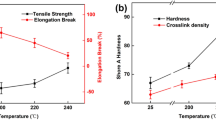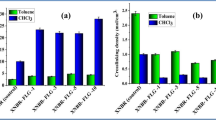Abstract
In this study, a composite of a natural rubber (NR) discontinuous phase (dispersoid) and a graphene continuous phase (matrix) was prepared and characterized. Graphene was prepared and grafted onto NR particles in the latex stage in the presence of the redox initiators tert-butylhydroperoxide and tetraethylene pentaamine. The structure and morphology of the resulting materials were characterized through XRD, TEM and DSC. The mechanical and electromagnetic shielding properties of the samples were investigated and compared with those of an NR/graphene blend in which graphene forms a discontinuous phase. The results show that graphene, which is the minor component, can successfully form a matrix and that NR, which is the major component, acts as a dispersoid. The electromagnetic shielding and mechanical properties of NR with a graphene matrix are found to be superior to that for NR with graphene as the discontinuous phase. The improvement in the NR performance is attributed to the formation of a graphene matrix.
This is a preview of subscription content, access via your institution
Access options
Subscribe to this journal
Receive 12 print issues and online access
$259.00 per year
only $21.58 per issue
Buy this article
- Purchase on Springer Link
- Instant access to full article PDF
Prices may be subject to local taxes which are calculated during checkout








Similar content being viewed by others
Data availability
The data generated during and/or analyzed during the current study are available from the corresponding author on reasonable request.
References
Schweitzer PA. Mechanical and Corrosion-Resistant Properties of Plastics and Elastomers. New York: Marcel Dekker; 2000, pp.274–281.
James HM, Guth E. Theory of the elasticity of rubber. J Chem Phys. 1976;280:317–53.
Mooibroek H, Cornish K. Alternative sources of natural rubber. Appl Microbiol Biotechnol. 2000;53:355–65.
Mott P, Roland CJ. Elasticity of natural rubber networks. Macromolecules. 1996;29:6941–5.
Lerf A, He H, Forster M, Klinowski J. Structure of graphite oxide revisited. J Phys Chem B. 1998;102:4477–82.
Novoselov KS, Morozov SV, Mohinddin TMG, Ponomarenko LA, Elias DC, Yang R, et al. Electronic properties of graphene. Phys Stat Sol B. 2007;244:4106–11.
Neto AHC, Guinea F, Peres NMR, Novoselov KS, Geim AK. The electronic properties of graphene. Rev Mod Phys. 2009;81:109–62.
Hernández M, del Mar Bernal M, Verdejo R, Ezquerra TA, López-Manchado MA. Overall performance of natural rubber/graphene nanocomposites. Compos Sci Tech. 2012;73:40–46.
Yaragalla S, Meera A, Kalarikkal N, Thomas S. Chemistry associated with natural rubber–graphene nanocomposites and its effect on physical and structural properties. Ind Crop Prod. 2015;74:792–802.
Matos CF, Galembeck F, Zarbin AJJG. Multifunctional and environmentally friendly nanocomposites between natural rubber and graphene or graphene oxide. Carbon. 2014;78:469–79.
Nguyen TH, Do QV, Tran AD, Kawahara S. Preparation of hydrogenated natural rubber with nanomatrix structure. Polym Adv Tech. 2020;31:86–93.
Nguyen TH, Tran TT, Kawahara S, Ougizawa T. Preparation of polyaniline nanomatrix formed in natural rubber. Polym J. 2020;52:1357–65.
Gannoruwa A, Kawahara S. Distribution of nanodiamond inside the nanomatrix in natural rubber. Langmuir. 2018;34:6861–8.
Kawahara S, Kawazura T, Sawada T, Isono Y. Preparation and characterization of natural rubber dispersed in nano-matrix. Polymer. 2003;44:4527–31.
Sakdapipanich JT. Structural characterization of natural rubber based on recent evidence from selective enzymatic treatments. J Biosci Bioeng. 2007;103:287–92.
Paulchamy B, Arthi G, Lignesh BD. A simple approach to stepwise synthesis of graphene oxide nanomaterial. J Nanomed Nanotechnol. 2015;6:1000253.
Yamamoto Y, Nghia PT, Klinklai W, Saito Y, Kawahara S. Removal of proteins from natural rubber with urea and its application to continuous processes. J Appl Polym Sci. 2008;107:2329–32.
Guo HL, Wang XF, Qian QY, Wang FB, Xia XH. A green approach to the synthesis of graphene nanosheets. ACS nano. 2009;3:2653–9.
Hontoria-Lucas C, López-Peinado AJ, López-González JD, Rojas-Cervantes ML, Martín-Aranda RM. Study of oxygen-containing groups in a series of graphite oxides: physical and chemical characterization. Carbon. 1995;33:1585–92.
Yin K, Li H, Xia Y, Bi H, Sun S, Liu Z, et al. Thermodynamic and kinetic analysis of low- temperature thermal reduction of graphene oxide. Nano-Micro Lett. 2011;3:51–55.
Ravinder R, Kumar R, Agarwal M, Krishnan NMA. Evidence of a two-dimensional glass transition in graphene: insights from molecular simulations. Sci Rep. 2019;9:1–9.
Justh N, Berke B, László K, Szilágyi IM. Thermal analysis of the improved Hummers’ synthesis of graphene oxide. J Therm Anal Calorim 2018;131:2267–72.
Alam SN, Sharma N, Kumar L. Synthesis of graphene oxide (GO) by modified hummers method and its thermal reduction to obtain reduced graphene oxide (rGO)*. Graphene. 2017;6:1–18.
Van der Vegt AK. From polymers to plastics. Delft University Press, 2006, pp.117–142.
Lampman S. Characterization and failure analysis of plastics. ASM International publisher, 2003, pp.183–203.
Tripathy AR, Morin JE, Williams DE. A novel approach to improving the mechanical properties in recycled vulcanized natural rubber and its mechanism. Macromolecules 2002;35:4616–27.
Nguyen TH, Cao HH, Do LVH, Nguyen PDL, Tran TT, Phan TN, et al. Preparation of electromagnetic shielding coating based on natural rubber. Mat Trans. 2020;61:1544–9.
Treloar LRG. Elastic recovery and plastic flow in raw rubber. Trans Faraday Soc. 1940;35:538–49.
Acknowledgements
This work was supported by the Toshiba International Foundation (2019).
Author information
Authors and Affiliations
Corresponding author
Ethics declarations
Conflict of interest
The authors declare no competing interests.
Additional information
Publisher’s note Springer Nature remains neutral with regard to jurisdictional claims in published maps and institutional affiliations.
Rights and permissions
About this article
Cite this article
Pham, M.D., Nguyen, Q.H., Nguyen, Q.T. et al. Graphene matrix formation in a natural rubber dispersoid. Polym J 54, 727–733 (2022). https://doi.org/10.1038/s41428-022-00620-4
Received:
Revised:
Accepted:
Published:
Issue Date:
DOI: https://doi.org/10.1038/s41428-022-00620-4
This article is cited by
-
Biocompatible membrane from the natural rubber-grafted-(2-hydroxyethyl methacrylate) and its metal removal application
Macromolecular Research (2024)
-
Preparation of Conductive Hydrogel Based on Wastepaper
Journal of Polymers and the Environment (2023)



